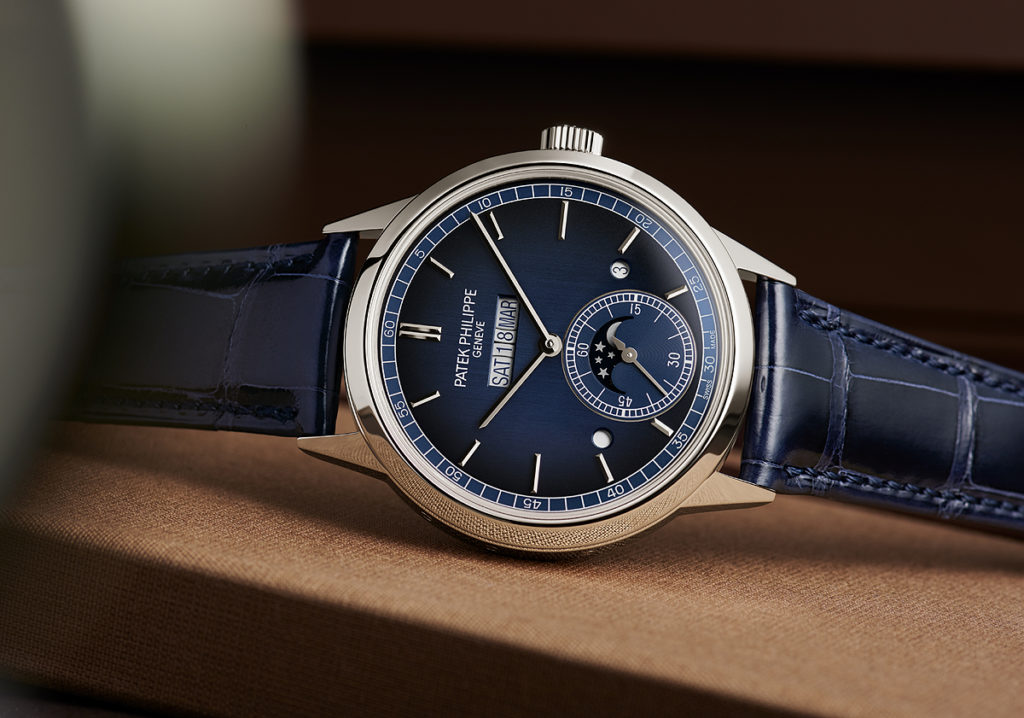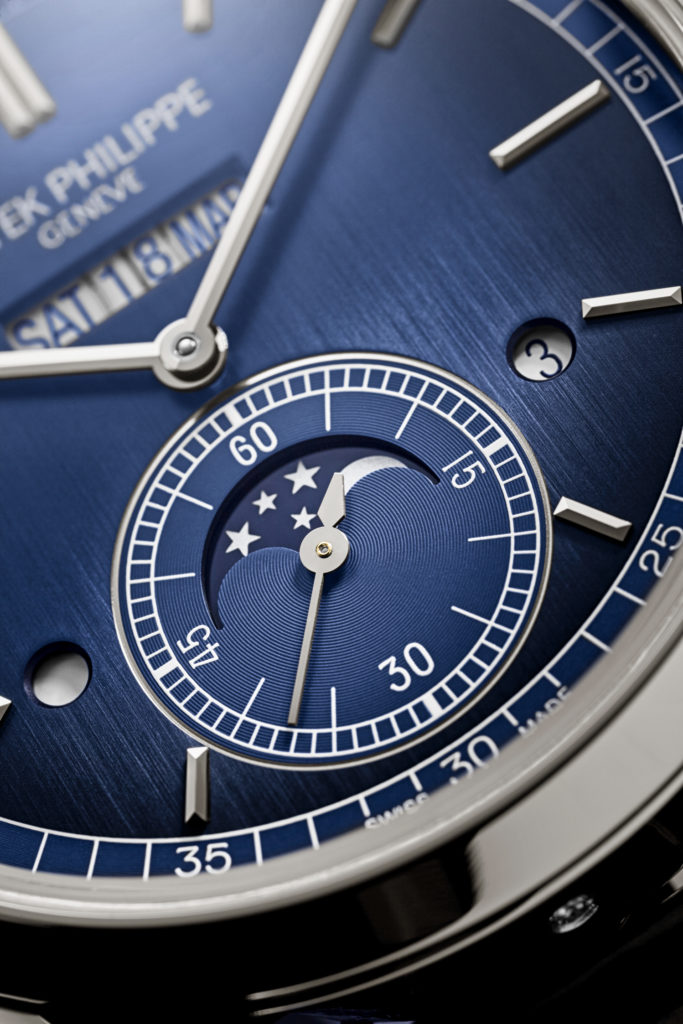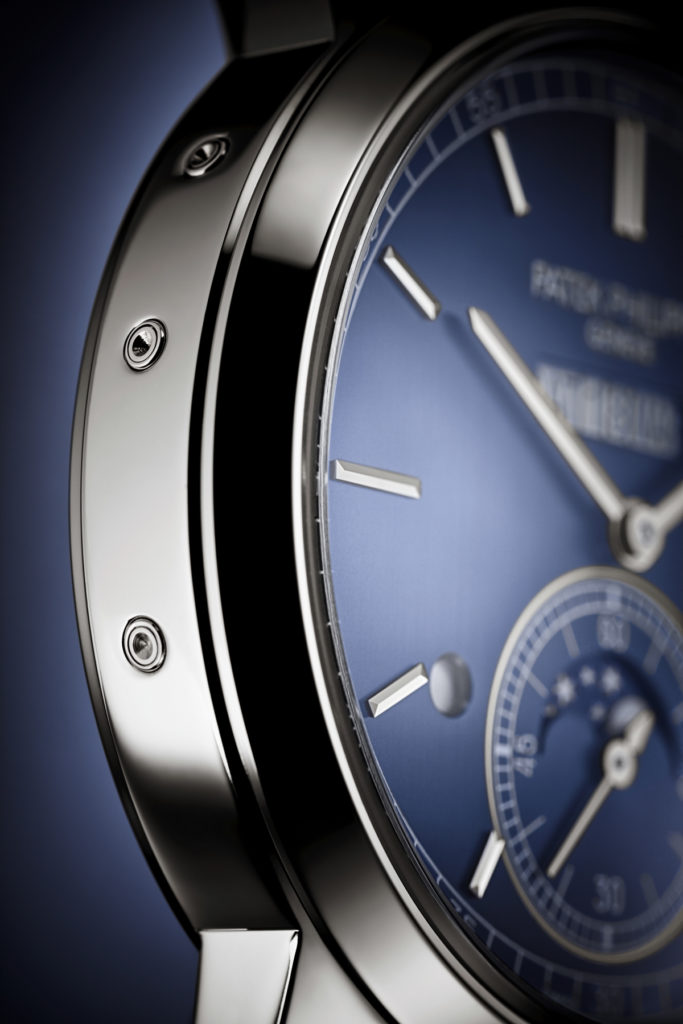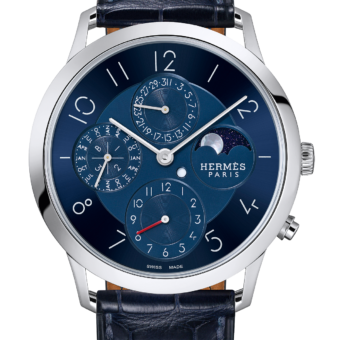Patek Philippe’s most buzz-generating release at its inauguaral Watches & Wonders appearance earlier this month was undoubtedly the green-dialed Nautilus that marked the finish line for the production of that sport-luxury reference. But the manufacture’s most technically significant new model, which made its debut in the wake of that release, came from its venerable, classically elegant Calatrava collection. The new Ref. 5236P-001 In-Line Perpetual Calendar offers an all-new (and patented) take on the perpetual calendar wristwatch.

The new watch features the day, date, and month on a single line in a long, horizontal aperture beneath 12 o’clock, an arrangement that Patek Philippe has used in pocketwatches throughout its history — like the Ref. P-1450 from 1972, a piece now on display at Patek’s museum in Geneva — but never before in a wristwatch. Presented in a 41.3-mm case made of 950 platinum, with a lacquered blue gradient dial and housing a new self-winding movement, the model further solidifies Patek Philippe’s multi-generational expertise in crafting perpetual calendars for the wrist, which began with its first such model in 1925.

One of the biggest challenges Patek’s watchmakers had to overcome was creating a legible calendar display on a single line. Their solution was to use four disks — one for the day, two for the date, one for the month — embedded in the same plane, rather than a single 31-day disk, which would have been too small to read. As the base for the new movement, they used Patek’s Caliber 31-260 REG QA, launched in 2011 inside the Ref. 5235 Annual Calendar model, whose recessed micro-rotor allowed it to be extraordinarily slender. This caliber was completely reworked and renamed Caliber 31-260 PS QL — “PS” for “petite seconde,” “QL” for “quantième perpétuel en ligne,” or inline perpetual calendar. Somewhat amazingly, the perpetual calendar-equipped movement retains the same diameter and height as its annual calendar-equipped base (31.74 mm in diameter, 2.6 mm high) despite an array of added components.


Patek Philippe increased the torque of the spring barrel by 20 percent and boosted the winding power by upgrading the base movement’s 22k gold micro-rotor to an even heavier one made of platinum. The movement’s overall rate stability has been increased from 3.2 Hz to 4 Hz (28,800 vph). The engineers added new bridges for the escapement and fourth wheel in the service of affording the watch’s owner a better view of elements like the wheel train and other finely finished parts through a sapphire caseback.

Designed as a separate module with its own plate, the perpetual calendar mechanism is integrated into the movement via an intermediate wheel, which connects with the hour-wheel pinion that controls the minute hand and meshes with a 24-hour wheel to guarantee efficiency. Comprising no less than 118 components of this module are the four rotating disks of the single-line calendar display, which are kept on a one plane without overlap thanks to a patent-pending mechanism with two co-planar double ball bearings. A second patent was filed for the “anti-double-jump” system that guarantees the synchrony of the date disks and prevents them from bouncing during correction or when being impacted. The clever mechanism that immobilizes the units disk when the date transitions from the 31st to the 1st of the month represents the third of the three patent applications filed.

Balancing out the in-line displays are round windows at 4 o’clock for the leap-year indication and at 8 o’clock for the day-night indication, as well as a a high-precision moon-phase display, a hallmark of Patek Philippe perpetual calendars, within the small seconds subdial at 6 o’clock. User-friendliness, in addition to legibility and compactness, was a watchword in the watch’s development, as evidenced by the day, date and month correctors, recessed into the case flank between 9 and 2 o’clock in the same order as their respective displays, and the moon-phase corrector at 8 o’clock.


The platinum case is hand-polished, with the chamfered bezel and angled lugs that are characteristic of the Calatrava model, and features a subtle diamond recessed into the case flank at 6 o’clock. The blue dial features a gradation to black on its outer periphery and hosts applied, baton-style hour markers and hands in white gold, with double faceted edges. The movement holds a power reserve of 48 hours and, like all Patek Philippe in-house calibers since 2009, it meets the strict criteria for the maison’s in-house quality seal, exceeding the standards of the Swiss watch industry’s respected poinçon de Genève certification. The watch is delivered on a navy blue alligator strap with a platinum fold-over clasp and is priced in the U.S. at $130,108.









In another post regarding another brand someone mentioned the word “exquisitry”. If such a word even exists, then this Patek Calatrava would be the very definition of that word…
This watch is very pleasing to look at. The dial layout leaves lots of expanse to show off the lacquered blue enamel dial surface while discreetly showing every indication for a perpetual calendar. I think it will be very popular.
Give that this is a watch in the Grand Complications collection it is quite disappointing not to see a single interior angle on the movement. The company is cutting corners when it comes to the hand-finishing of the movement.